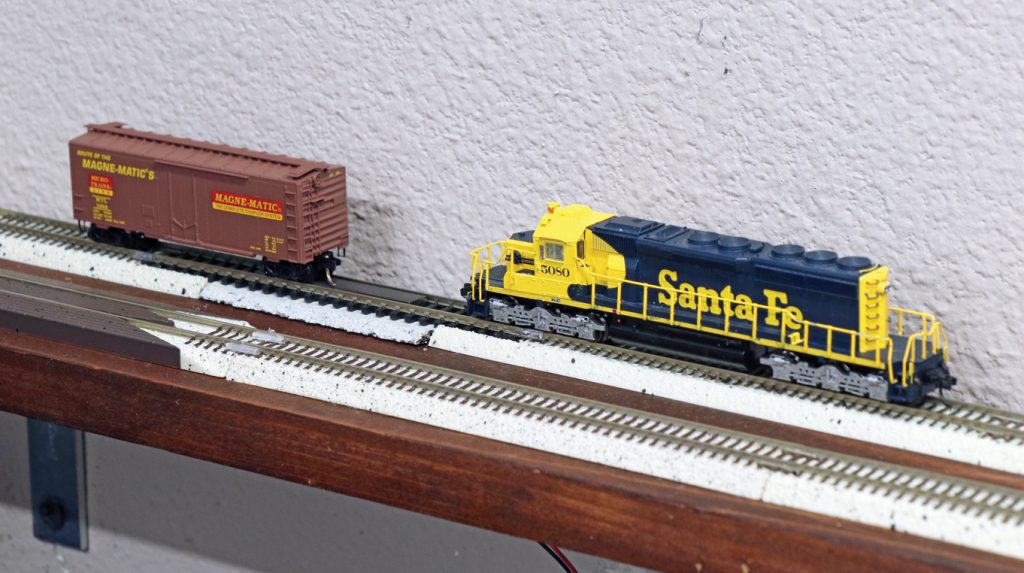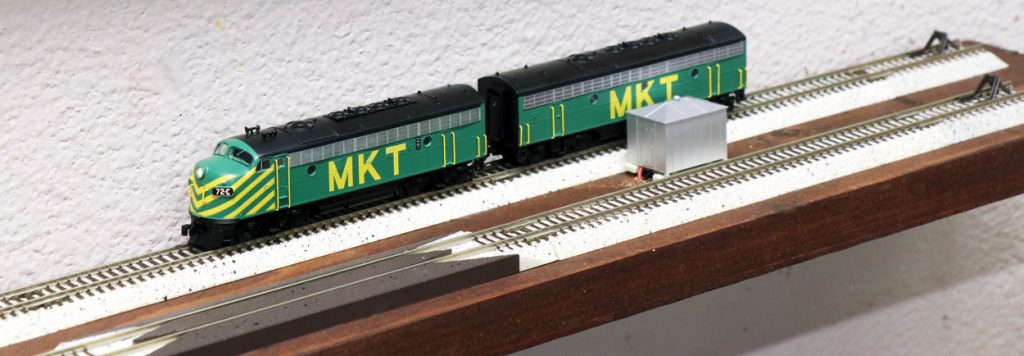All about the community of model railroading and rail enthusiasm

This review appeared in the May/June 2025 Cowcatcher.
By TIM BLACKWELL/Cowcatcher Magazine
When the N-scale Whitehurst & Pine Ridge moved to a new layout room six years ago, an existing cedar workbench quickly became the maintenance center.
The first addition was a 70-inch test track on 1-inch x 2-inch trim. The track consisted of previously used flex and section Atlas Code 80 and a magnetic uncoupling ramp on a few spare pieces of cork roadbed. It was wired with a toggle for DC and DCC operation.
The track lacking a re-railer and being too close to the wall made placing and removing rolling stock cumbersome. And programming DCC locomotives using an old Digitrax Zephyr required switching power feeds to program mode.
Eventually, the track showed its age and connectivity issues persisted.
Time to start over.
The new test track would have dual “main lines” with an isolated DCC programming track on one.
Spring cleaning under the layout one evening uncovered a box containing some Atlas Model Railroad Co. products. Atlas had sent several packages of light gray Code 65 True-Track following its debut around 2009.
Here was almost enough to build the expanded test track. Atlas partnered with the Cowcatcher to provide the additional pieces so we could seal the deal.
Like similar products from other manufacturers, True-Track is a modular system that snaps together quickly and easily. Fashioned after the company’s successful HO True-Track line, it appeals to beginners and those who may only want a simple, temporary layout.
Sections with Code 65 rails and ties molded into simulated ballasted roadbed connect using traditional rail joiners and a locking mechanism for a tight fit. Accurate brown ties are prototypically spaced, and ballast, which comes in light gray and gray, is realistic.
True-Track is ideal for building a simple layout on the floor, a shelf or a coffee table. Atlas recommends a layout be assembled in sections on a hard surface before placing on carpet.
The roadbed has uniformly beveled sides and, with a tapered transition piece, connects to Code 80 and Code 55 standard rail. This opens possibilities for mingling it with an existing layout.
True-Track comes in 1-, 2-, 6- and 10-inch straight sections, a 90-degree crossing and two turnout options (No. 5 and 12.5-inch) plus 11-, 12.5- and 15.5-inch radius curves and a few odds and ends, including beveled track sections for turnouts. Terminal, re-railer and transition tracks for Code 80 and Code 55 rail come in 6-inch sections.
Planning the test track took more time than actually putting it together. Within about two hours, both main lines were together, wired and functional.
Two parallel tracks about 70 inches long are connected by a pair of No. 5 left remote turnouts roughly in the middle, mounted on a stained piece of 1×4 cedar lumber.
The main lines are a mix of 2-, 6- and 10-inch light gray straight sections plus two terminal tracks, a pair of re-railers, four track bumpers and a transition track for an Atlas magnetic uncoupling ramp (see Bill of Materials).

A terminal track on Track 2 includes dual wire connections inside a simulated electrical box that hooks to the power source. Atlas also offers wired terminal joiners.
The uncoupling ramp on Track 2 connects on both ends with Code 80 transition tracks.
The front track, or Track 1, is just an inch or so shorter than Track 2. At the far left end is the DCC test track, isolated from the main line using standard insulated rail joiners. The isolated track is wired separately to the Zephyr and allows programming DCC locomotives while not disturbing any that may be sitting on the main.
The track easily snapped together and maintained good connectivity. A dab of solder was added to each rail joiner connecting the uncoupling ramp and the tapered end of the transition piece, which has no True-Track connector.
Once positioned, the track was secured to the board with small drops of white glue to eliminate the risk of movement during use (there are no holes for track spikes on traditional track). Track was left overnight to dry.
Several old and new locomotives and rolling stock with varying wheel flange sizes ran quietly and smoothly during initial testing. Only an older Lifelike GP20 locomotive clattered with its pizza-cutter wheels, but even it ran fine.
True-Track is slightly more expensive than Atlas’ standard track, but the trade-off is the all-in-one track and roadbed. A six-piece package of 6-inch True-Track goes for $17.25 on Atlas’ website, compared to a six-piece package of 5-inch Code 80 track at $5.46 from an online retailer.
Retail cost to build the W&PRR test track was about $215 (not including the wooden base), but a single straight track at a similar length with two bumpers and a package terminal joiners could be done for around $75.
For the W&PRR, the convenience of True-Track is well worth the price. The new test track adds a professional look to the workbench and functions reliably.
Read our other reviews
Visit our product review page here.